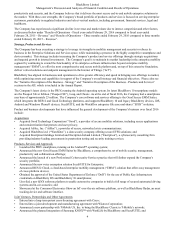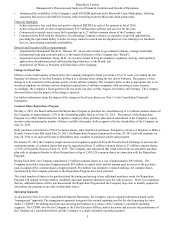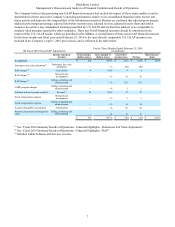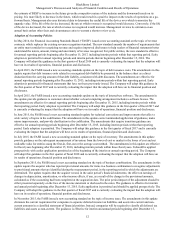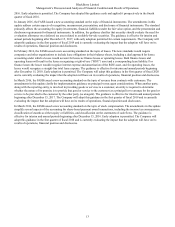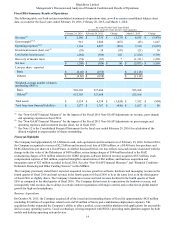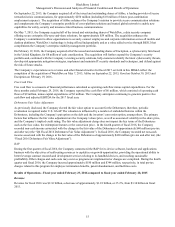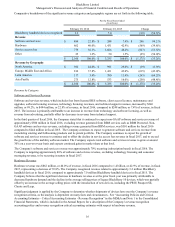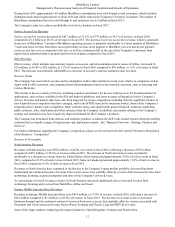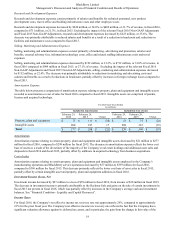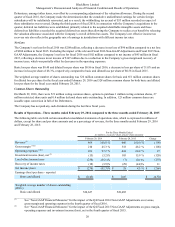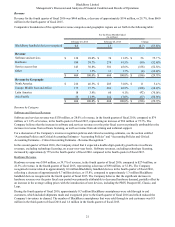Blackberry 2016 Annual Report Download - page 119
Download and view the complete annual report
Please find page 119 of the 2016 Blackberry annual report below. You can navigate through the pages in the report by either clicking on the pages listed below, or by using the keyword search tool below to find specific information within the annual report.
BlackBerry Limited
Management’s Discussion and Analysis of Financial Condition and Results of Operations
11
written down to net realizable value or excess inventory is written off. Significant judgment was required in calculating the
inventory charges, which involved forecasting future demand and the associated pricing at which the Company can realize the
carrying value of its inventory.
Valuation Allowance Against Deferred Tax Assets
The Company regularly assesses the need for a valuation allowance against its deferred tax assets. A valuation allowance is
required for deferred tax assets if it is more likely than not that all or some portion of the asset will not be realized. All available
evidence, both positive and negative, that may affect the realization of deferred tax assets must be identified and considered in
determining the appropriate amount of the valuation allowance. Additionally, for interim periods, the estimated annual effective
tax rate should include the valuation allowance for current year changes in temporary differences and losses or income arising
during the year. For interim periods, the Company needs to consider the valuation allowance that it expects to recognize at the
end of the fiscal year as part of the estimated annual effective tax rate. During interim quarters, the Company uses estimates
including pre-tax results and ending position of temporary differences as at the end of the fiscal year to estimate the valuation
allowance that it expects to recognize at the end of the fiscal year. This accounting treatment has no effect on the Company’s
actual ability to utilize deferred tax assets to reduce future cash tax payments. Different judgments could yield different
results. See “Results of Operations - Three months ended February 29, 2016 compared to three months ended February 28,
2015 - Income Taxes”.
Revenue Recognition
Significant judgment is applied by the Company to determine whether shipments of devices have met the Company’s revenue
recognition criteria, as the analysis is dependent on many facts and circumstances. Commencing in fiscal 2016, the Company
was able to conclude that the price was fixed or determinable on shipment in certain cases and, therefore, the four criteria as
described in Note 1 to the Consolidated Financial Statements for revenue recognition were met upon shipment. As such, sales
of the Company’s Android device to wireless carriers in certain regions, sales of the Company’s latest BlackBerry 10 devices to
wireless carriers in certain regions, and sales of BlackBerry 7 devices to wireless carriers in certain regions are recognized as
revenue at the time of shipment. Other shipments of Android, BlackBerry 10 and BlackBerry 7 devices are recognized as
revenue when the devices sell through to end users.
Hardware
The Company’s use of customer incentives requires management to use significant judgment in evaluating whether prices for
handheld devices are fixed or determinable, which can impact the timing of when hardware revenue is recognized. When the
price isn’t considered fixed or determinable, the Company recognizes revenue when the product is sold through to its end users.
The Company must take into account its past history with its carrier and distribution partners to determine whether it can
reliably estimate whether any future concessions will be provided on products it has previously sold into the channel. The
Company also makes estimates of the level of channel inventory and the likelihood it will sell-through at the prices sold to its
distribution partners. The Company also has to consider external factors such as end customer demand, market acceptance of its
products, cannibalization of new product introductions, the competitive landscape, and technological obsolescence in
determining whether the price is fixed or determinable at the time of shipment. These factors could result in the Company
increasing its customer incentive programs which could impact the results of the Company’s operations. The Company
recognizes these customer incentives at the later of when the Company has recognized the product sale or when the program is
offered.
The Company also uses estimates in determining return provisions for its hardware sales. The Company has limited rights of
return for quality defects based on contractual terms and conditions. The Company’s historical experience is that returns for
defects are immaterial to the results of operations and represent only 0.5% to 1% of total units shipped. However, if defect rates
were to increase beyond those estimated, the Company would be required to recognize additional reductions to revenue. If the
defect rate were to change such that the Company could no longer reliably estimate the return rate, recognition of revenue
could be delayed until a reliable estimate could be made or the return period lapses.
Multiple Element Arrangements
The Company’s process for determining best estimated selling prices (“BESPs”) as it relates to when and if available upgrade
rights to the BlackBerry 10 and Android devices exist involves management’s judgment and multiple factors are considered
that may vary over time depending upon the unique facts and circumstances related to each deliverable. The objective of BESP
is to determine the price at which the Company would transact a sale if the product or service was sold on a stand-alone basis.
Should future facts and circumstances change, the Company’s BESPs and the future rate of related amortization for software
upgrades and non-software services related to future sales of these devices could change. Factors subject to change include the
unspecified software upgrade rights offered, change in pricing of elements sold separately by the Company in the future, the
estimated value of unspecified software upgrade rights, the estimated or actual costs incurred to provide non-software services,
and the estimated period software upgrades and non-software services expected to be provided. Management does not expect





